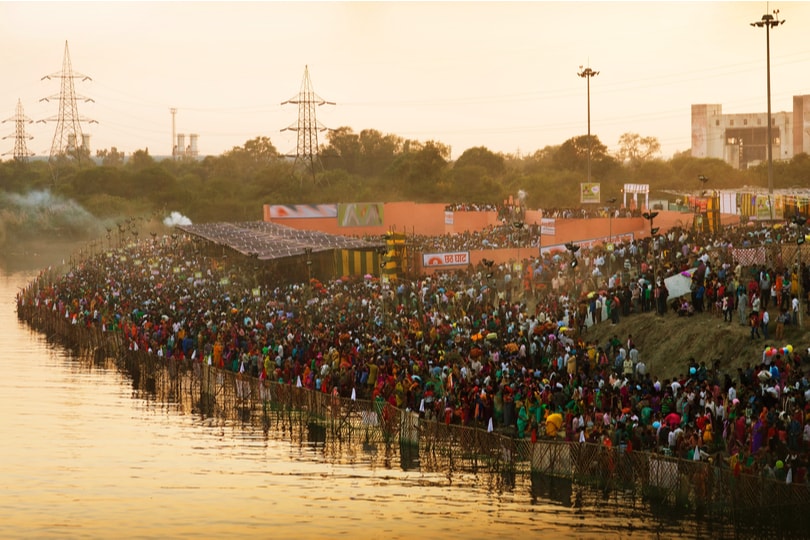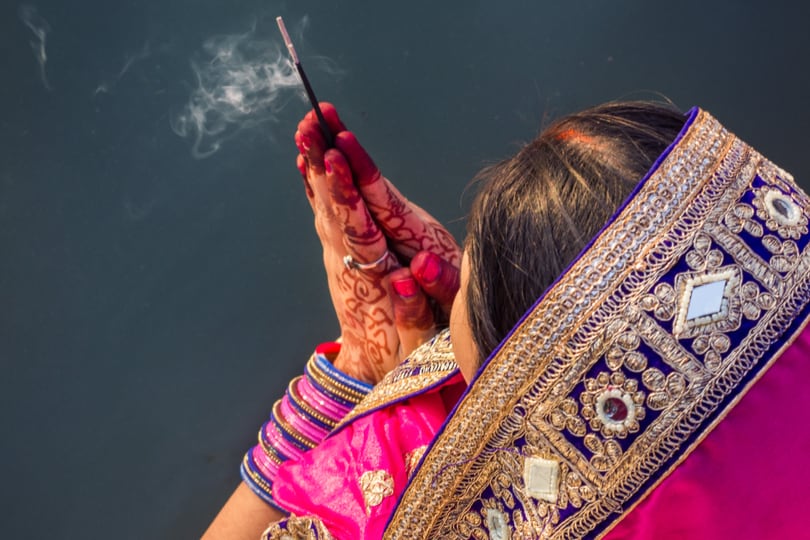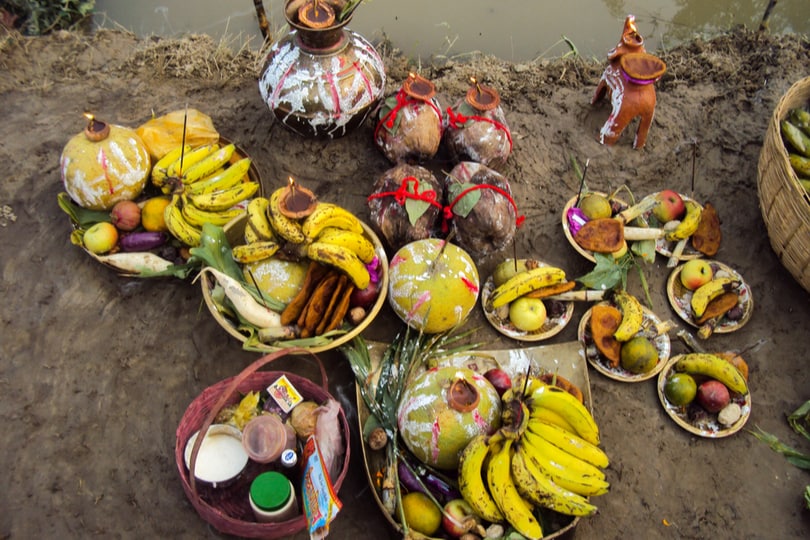India is a land of festivals that are celebrated throughout the year in different corners of the country with joy and enthusiasm. One of the most important festivals celebrated just after a week of Diwali is Chhath Puja. Chhath Puja is a festival devoted to Sun God Surya and his wife Usha, who is also known as Chhathi Maiya. During Chhath Puja, people thank Lord Surya, the god of energy and life-force for sustaining the life of Earth. Devotees believe that the Sun is also a source of healing and helps to cure many illnesses and diseases.
The word “Chhath” translates to sixth in Bhojpuri, Maithili and Nepali dialects. The festival is celebrated on the 6th day of the Kartikeya month of the Hindu calendar and hence is known as the Chhath Puja. According to the English Calendar, it falls in the month of October or November. This festival lasts for 4 days, which makes it the longest festival after Navratis.
Chhath puja 2019 will be celebrated from October 31 to November 3.
Chhath Puja is celebrated elaborately in Bihar, Jharkhand and certain regions of Uttar Pradesh and Nepal. It is also celebrated in Madhya Pradesh, Chhattisgarh, Chandigarh, Gujarat, Delhi, and Mumbai. Being the most prominent festival of Bihar and Jharkhand, Chhath Puja is celebrated with great zeal. Lakhs of devotees from across the country gather at rivers, dams, ponds, ghats, and other water bodies to offer prayers. Chhath puja is the most important Bihar festival and has a distinct flavor that attracts so many people that authorities have to make special arrangements.

The Sun is believed to be the primary source of energy that supports life on earth. Therefore, during the Chhath Puja, also known as Chhath parab in some places, people thank the Sun God for supporting life and seek his blessings. People also ask Lord Surya for the longevity and prosperity of their family members and loved ones. Devotees offer their gratitude to the Sun God along with the goddess Usha, the first rays of the morning, and Pratyusha, last ray of the evening.
Apart from the religious significance, there is also some science associated with the rituals of Chhath Puja. To complete the rituals, devotees have to stand at the banks of the rivers for long hours. So these rituals take place in the morning and evening as the ultraviolet rays of the sun are at their weakest during the sunrise and sunset. The sun rays at these moments are extremely beneficial and help in the detoxification of the body, mind, and soul.
The significance of Chhath Puja is also agricultural. This is referred to as a post-harvest festival, where people show gratitude for a good harvest in the season just ended.

Chhath Puja is considered to be one of the oldest rituals mentioned in the prominent mythological scriptures. The Rigveda also contains some hymns worshipping the Lord Surya. Chhath Puja has found a place in the pages of both Ramayana and Mahabharata.
In the Ramayana, the Chhath ritual was performed by Lord Rama and Sita after their return from the exile of 14 years. It is believed that Sita Charan temple in Munger, Bihar is the place where she performed the Chhath vrat.
According to the Mahabharata, Lord Surya’s son Karna was the first person to perform some of these rituals. He offered prayer to the Sun god standing in the water and offered Prasad to the needy. This gradually became a ritual of the Chhat Puja. Later, Draupadi and the Pandavas performed these rituals to regain their lost kingdom.

The 4-day rituals of Chhath Puja include taking holy baths in the river, fasting, and offering Prasad and arghya to the sun during sunrise and sunset.
On the first day, devotees take a bath in the holy water of Ganga early in the morning. After this they prepare prasad to offer to the Sun god. The entire house and surroundings are purified with Ganga Jal. People observe fast and eat just one meal in the entire day. They prepare chane ki daal, kaddu ki sabzi, and kheer in bronze or soil utensils. Salt is not added in the preparation of this meal.
During the second day, the devotees fast for the entire day and break it after worshipping the Sun god in the evening. A special meal of Tasmai (a dish similar to kheer) and puris is offered to the Sun god, after which devotees can break their fast. After worshipping the god and breaking their fast, people again fast for the next 36 hours. They go without water and food during this time.
The third day of Chhath Puja is also observed by fasting and without drinking even a drop of water. On this day, the children of the family prepare bamboo baskets and fill them with seasonal fruits like apples, oranges, bananas, dry fruits and sweets like ladoo, saanch, and thakua. The male members take the basket in their heads to the riverside. These baskets are kept open at the ghats where the Vratin takes a dip, and offer ‘arghya’ to the setting sun. These baskets are brought back to the house after the ritual.
At night, a colorful event called Kosi is celebrated by lighting diyas under five sugarcane sticks while singing folk songs and mantras. These five sticks represent the five elements of nature or the Panchatattva which includes the earth, water, fire, air, and space.
On the last day, devotees gather with their families on the banks of the River before sunrise. The baskets are brought back to the ghats and vratin takes a dip in the water and offer prayers and prasad to the Sun and Usha. After the offerings, the devotees break their fast and have Prasad from the baskets.
On the way back home, the vratin worship the soil as a gesture of thanks for providing them with food.

The process of Chhath Puja is divided into six stages of purification and infusion of cosmic solar energy which are –
It is believed that these rituals detoxify the body and mind and provides mental calmness. It also enhances immunity, infuses energy and reduces the frequency of anger, and all other negative emotions.

Although celebrated in many Indian states, the Chhath Puja celebrations in Bihar and Jharkhand have a distinct charm. Both of these places attract a crowd of devotees from around the country during this time.
Bihar celebrates Chhath Puja with great enthusiasm and splendor. The city is visited by millions of devotees and all the water bodies turn into places to offer prayer.
In Bihar, the following places are best to experience and enjoy the Chhath Puja celebrations.
This city situated on the banks of the holy Ganga, celebrates the festival on a grand level. This is indeed the best place to offer prayers and witness the magnificent celebrations across the city.
The Kaunhara ghat located on the banks of the Ganga-Gandaki confluence is decorated with lights and diyas all over and is visited by devotees and vratins. The ghats and other water bodies of Hajipur are a sight to behold.
It is believed that Sita performed the Chhath Puja rituals at the Sita Charan temple located in Munger. You can witness lakhs of devotees taking a dip in the water on the Kastaharni Ghat, on the banks of the holy Ganges.
If you wish to visit Jharkhand during the celebrations, the best places are –
The most popular spot for the rituals is the Ranchi Lake. Apart from this, there are other ponds and ghats, including Button Talab, Kunkay Talab, and Hatia Ghat, are famous spots for Chhath puja celebrations.
The ghats of Bagbera, mango, and Sidhgora are some of the favorite spots for the devotees to offer prayers to the Sun god. The banks of Kharkai and Subarnarekha are also full of people and colorful decorations.
Find Best Hotels In Jamshedpur
Bokaro’s Ganga river and the seven ghats along the river see devotees from around the country. The ponds and reservoirs including the Cooling pond, City park pond, and Rani Pokhar pond are also flocked by the devotees.
Chhath Puja is a celebration devoted to the Sun and nature. All the rituals associated with the Chhath Puja revolve around nature and its gifts. This festival is known for its simplicity and purity. All the rituals are performed for the purity of the body and soul. The most unique feature of this festival is the fact that unlike all the other major Hindu festivals, there is no idol worship. This festival is a way to pay tribute to the Sun that sustains life on the earth. Every person irrespective of their cast and religion should witness the celebrations of this amazing festival in the states of Bihar, Jharkhand and Uttar Pradesh at least once.

Please go back to portrait mode for the best experience